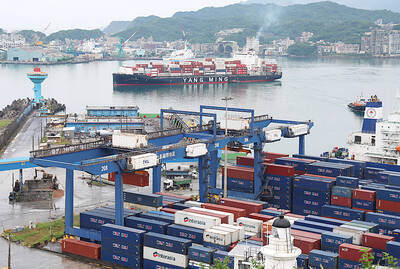China said yesterday it would soon launch a stock index covering 500 firms listed in China, Hong Kong and Taiwan to enhance financial cooperation in the Greater China region.
China Securities Index Co (中證指數公司), established by China’s two bourses in Shanghai and Shenzhen, will start to publish the CSI Cross-Straits 500 Index on Jan. 18, the company said in a statement.
Following the signing of three memorandums of understanding between China and Taiwan in November, “the cooperation in financial sectors across the straits [sic] is now entering a substantial phase,” it said.
The documents — on banking, insurance and securities — are expected to help pave the way for Taiwan’s finance industry to gain greater access to the huge Chinese market and open up the possibility of more investment activity.
The new index “caters to investors’ need to observe and invest in markets in the three places and provides a basic instrument for developing index-related products and derivatives,” the statement said.
A number of domestic and overseas institutions are making “proactive” preparations to develop investment products based on the new index for the Greater China region, it added, without giving more details.
The company will publish the index denominated in yuan, US dollars, Hong Kong dollars and New Taiwan dollars, while the components will have a combined market value of about 3.2 trillion yuan (US$468.5 billion).
It covers 75 percent of the total market capitalization of the stock markets in China, Hong Kong and Taiwan, and 53 percent of the combined trading volume.

CHIP RACE: Three years of overbroad export controls drove foreign competitors to pursue their own AI chips, and ‘cost US taxpayers billions of dollars,’ Nvidia said China has figured out the US strategy for allowing it to buy Nvidia Corp’s H200s and is rejecting the artificial intelligence (AI) chip in favor of domestically developed semiconductors, White House AI adviser David Sacks said, citing news reports. US President Donald Trump on Monday said that he would allow shipments of Nvidia’s H200 chips to China, part of an administration effort backed by Sacks to challenge Chinese tech champions such as Huawei Technologies Co (華為) by bringing US competition to their home market. On Friday, Sacks signaled that he was uncertain about whether that approach would work. “They’re rejecting our chips,” Sacks

Taiwan’s exports soared 56 percent year-on-year to an all-time high of US$64.05 billion last month, propelled by surging global demand for artificial intelligence (AI), high-performance computing and cloud service infrastructure, the Ministry of Finance said yesterday. Department of Statistics Director-General Beatrice Tsai (蔡美娜) called the figure an unexpected upside surprise, citing a wave of technology orders from overseas customers alongside the usual year-end shopping season for technology products. Growth is likely to remain strong this month, she said, projecting a 40 percent to 45 percent expansion on an annual basis. The outperformance could prompt the Directorate-General of Budget, Accounting and

NATIONAL SECURITY: Intel’s testing of ACM tools despite US government control ‘highlights egregious gaps in US technology protection policies,’ a former official said Chipmaker Intel Corp has tested chipmaking tools this year from a toolmaker with deep roots in China and two overseas units that were targeted by US sanctions, according to two sources with direct knowledge of the matter. Intel, which fended off calls for its CEO’s resignation from US President Donald Trump in August over his alleged ties to China, got the tools from ACM Research Inc, a Fremont, California-based producer of chipmaking equipment. Two of ACM’s units, based in Shanghai and South Korea, were among a number of firms barred last year from receiving US technology over claims they have

BARRIERS: Gudeng’s chairman said it was unlikely that the US could replicate Taiwan’s science parks in Arizona, given its strict immigration policies and cultural differences Gudeng Precision Industrial Co (家登), which supplies wafer pods to the world’s major semiconductor firms, yesterday said it is in no rush to set up production in the US due to high costs. The company supplies its customers through a warehouse in Arizona jointly operated by TSS Holdings Ltd (德鑫控股), a joint holding of Gudeng and 17 Taiwanese firms in the semiconductor supply chain, including specialty plastic compounds producer Nytex Composites Co (耐特) and automated material handling system supplier Symtek Automation Asia Co (迅得). While the company has long been exploring the feasibility of setting up production in the US to address